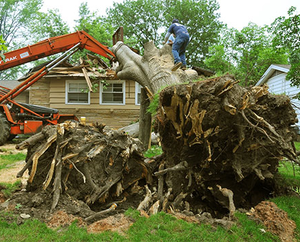 Storms can come in the most unexpected time. Heavy rains, strong winds, and snow can cause terrible damage to your trees. It is a must for you to assess your tree following a storm to make sure it is not a safety hazard for your property or family.
Storms can come in the most unexpected time. Heavy rains, strong winds, and snow can cause terrible damage to your trees. It is a must for you to assess your tree following a storm to make sure it is not a safety hazard for your property or family.
Inspection before a Storm
It is always best to regularly inspect your trees all year round and not just after a storm. This will encourage better health and appearance on your tree and prevent future problems. Broken branches can fall anywhere your property and can cause grave damage and injury. Tree care, such as pruning and trimming, should be an integral part of maintenance to avoid worst-case scenarios like these. Make a habit of inspecting your tree before and after a storm. Contact Matt at Nabor’s Tree Service Chattanooga for more information.
Identify Broken Branches
It is easy to miss broken branches, especially if you are not a certified arborist. These branches can be a safety hazard to you and your property. Broken branches that hang on a tree should be removed before they even fall off. Also, they are vulnerable to many types of infections and diseases that can cause the decline of your tree. You should get in touch with a tree professional because they have the skills and specialized approach for treating diseases among trees. You should have your tree inspected for any cracks or split branches. These physical damages are sometimes challenging to see if you don’t climb up the tree.
Look for Leaning Trees
When you see a leaning tree after a storm, this tree is likely to fall after another storm. Keep in mind that no matter how little the tree leans, it is still an indication of root damage and that tree has become hazardous. Professional tree care services can do something for trees that only lean slightly, so it’s best to contact them as soon as the storm ends.
Pre-Storm Pruning and Thinning
You can get great help from a certified arborist to take care of your tree before a storm hits your area. Thinning the canopy of your tree is one effective way to allow wind to pass through the branches. Pruning before the stormy season will help keep your tree’s shape and structure. It will also make sure that branches are not entangled with power lines.
Decisions, Decisions, Decisions
It can be tempting to do your own assessment of trees after a storm. However, it is best to get assistance from a professional arborist because he will know how to remedy the damaged trees and will give you a diagnosis of the overall health of your tree. Some trees can be saved while some need to be removed. In most cases, young trees that have small trunks can come back after getting storm damaged. Some tree species are not very prone to internal decay, but some species can easily decay and can no longer be saved after an internal decay. You also have to consider the tree’s health. A new tree with healthy and strong limbs has a higher chance of getting back its health compared to an old tree with rotting trunks.
Timing is Everything
Trees require a specific time to recover after it got damaged by a storm or when it lost its leaves. You shouldn’t prune branches from damaged trees. Restorative pruning is best performed after the tree has grown back its leaves. This will allow the tree to store energy through photosynthesis. You should allow the tree to recover its strength before pruning so that it can survive the stress related to pruning. If the storm damages half of the tree, it is likely to die over time. This tree should be removed immediately so that you can plant a new one in its place.
It is best if you will let the pros take care of your trees, especially after a storm. They can determine if your tree is worth saving or if it needs to be removed. Tree experts can also provide professional advice that can help the health of your tree in the days to come.